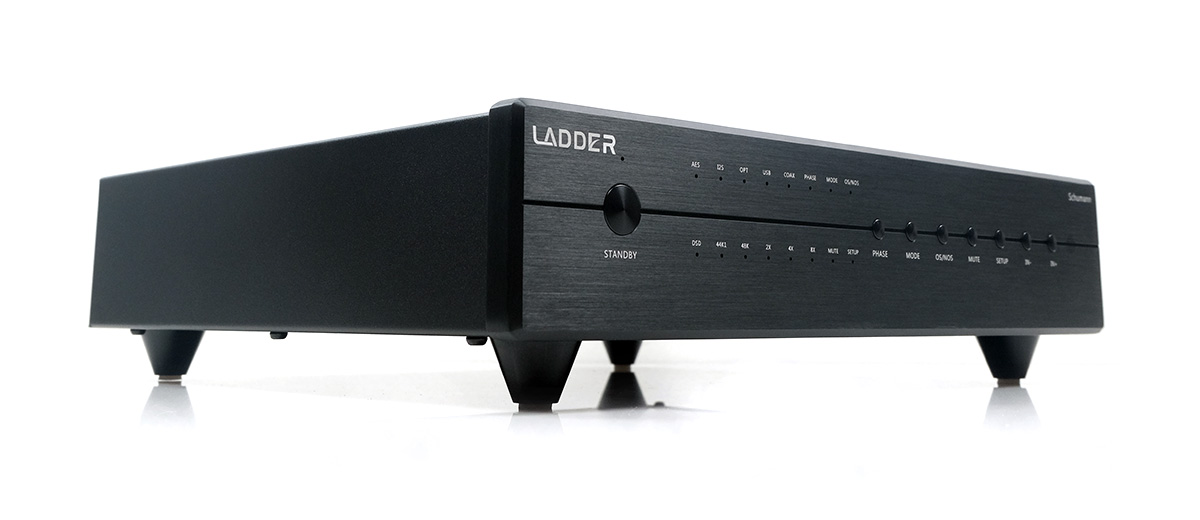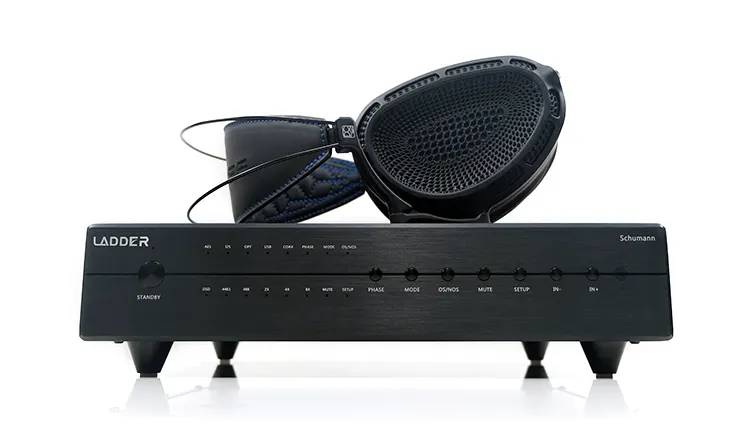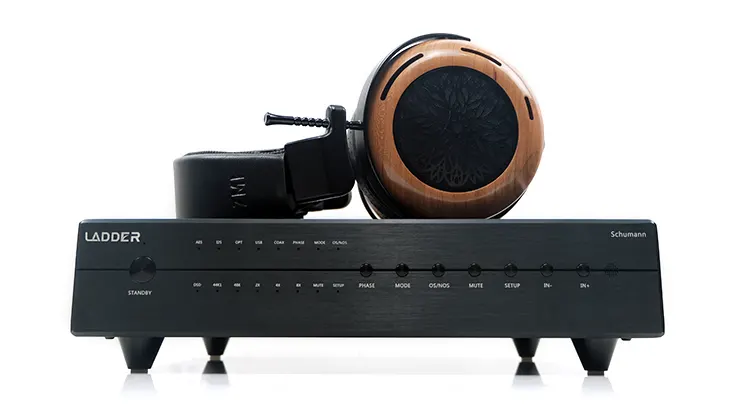Sound Impressions
The following sound impressions were compiled using a Ferrum OOR/HYPSOS PSU and amplifier in balanced output mode combined with a Cayin N7 as the main source via I²S. The test headphones included the Dan Clark Audio EXPANSE and the ZMF Headphone open-back Atrium.
Summary
The Ladder Schumann DAC is not an Ares II nor is it a rebadged Musician Audio Pegasus. It is sonically on another level to both of these alternatives. It still has those quintessential R-2R qualities, namely a very natural-sounding tonal sound signature with smoother leading edges and excellent detail in each note’s texture.
Where it jumps above these alternatives is the improved level of dynamic range combined with the amount of staging space and impressive layering it can inject into an amplifier’s overall presentation.
You will also get a very black background with solid-state performers like Ferrum’s OOR amplifier when paired with its HYPSOS PSU as well as an outstanding level of bass presence and definition also with any headphone that can amplify that.
Headphones such as the ZMF Headphones Atrium and the Dan Clark Audio EXPANSE sounded much beefier and more powerful with the OOR when paired with the Schumann DAC compared to the Pegasus for example.
Even previously reviewed DACs with a notable low-end coloration such as the ES9038 PRO implemented Little Dot DAC VII sounded equally as punchy but with slightly less sub-bass body using the aforementioned headphones and the OOR combo.
Treble presence is a little bit toned down but unsurprising for me and is a factor in that overall smoother and natural timbre from most of the setups I tested. There are a few R-2R DACs out there that I have tested that overcook the treble or come across as achingly neutral.
Switching to OS from NOS will enhance the treble presence but not hugely so. It is noticeable with headphones that can pick up on subtle changes in the mids and treble timbre so you can expect just a slightly sharper note leading edge and some enhanced natural sibilance.
Timbre
You get a number of subtle differences in the timbral presentation of the Schumann DAC with both OS and NOS changing the overall tone and staging quality slightly as well as the two OS filters adjusting the tonal quality even further.
At its core, it delivers a generally smooth and natural harmonic balance when combined with the OOR the Schumann DAC but not what I would describe as an overly warm or relaxed tuning.
There is enough sparkle and a revealing nature to its performance to give you subtle treble uplifts when required, especially in NOS which I find to be the more vibrant of the two modes available.
With OS, that little sparkle seems less raw, more processed, and slightly drier in its tonal quality using one filter and a little richer and fuller on the second filter.
The timbral quality is also firm and weighty with an excellent sub-bass tone or a physical quality to the lows in general. The textural detail and power from the Schumann DAC are superior to the likes of the delta-sigma ES9038PRO Little Dot DAC VII and make the Pegasus seem relatively flat sounding.
I hold the DAC VII in high regard for how Little Dot amplified the bass presence beyond neutral. However, compared to the Schumann DAC, it’s on par for mid-bass punch but somewhat lighter in tone right at the very low end with both the Atrium and the EXPANSE using the OOR amplifier.
Staging & Dynamics
There are no problems whatsoever with the perceived dynamic range of the Schumann DAC and it can compete with equivalent-priced DACs such as the Little Dot DAC VII in terms of resolution and imaging.
Of the three compared DACs on page 3, only the Chord Electronics Qutest gave the impression of a more intricate imaging performance to its mids and highs with the Schumann DAC impressing more on the lows.
Although not officially listed for Vrms and impedance SE or balanced the Schumann DAC sounds more open and dynamic than the Musician Audio Pegasus at equivalent volume levels from the Ferrum OOR using both the ZMF Headphones Atrium and DCA’s EXPANSE headphones.
The black background performance and level of separation are excellent with impressive width but for me, the standout is the depth and bass layering. It sounds dense in each note with superb textural quality but at the same time never felt congested or compressed in delivering that low-end presentation.
The headroom is better in NOS over OS to my ear, with vocal separation and imaging a bit clearer and easier to pick out at the same time. OS tends to just flatten the vocal imaging in the mids which takes a bit of presence and bloom away from their performances.
Synergy
I²S Compatibility
I am increasingly turning to I²S where possible for source-to-DAC connectivity these days for ease of use despite countless iterations that are technically non-standard in company-provided configurations. Meaning compatibility can be tough and via trial and error.
A good example of an I²S fail for me is Gustard with their X16 and X18 I²S inputs not playing ball at all with a NuPrime CDP-9, Cayin’s iDAP-6 and an N8ii DAP’s mini-HDMI output. Three devices that interconnect with each other just fine with a standard HDMI cable.
So the good news is that the Schumann DAC is 100% compatible with all the aforementioned devices and has been tested with 3 different HDMI cables, (v1.3 to v2.0), one of which is from as far back as 2006, (V1.3).
I must add also that is with the default pin configuration format with no need to run through the 8 different config modes to press down on any unintended distortion. Of course, every device is different so I can only vouch for Cayin and NuPrime source gear currently.
One additional benefit for me of I²S is I can also take my source out of the electrical grid and go battery with a Cayin DAP to supply the original digital signal. Noise and jitter are system-dependent but a dedicated battery-powered DAP should perform better than a mains-supplied 5V USB-A port from a standard laptop.
OS/NOS
You have to be cautious here since the Schumann DAC never came with a manual to declare if the default diode light-off mode was NOS or OS.
If you are familiar with the Pegasus then you know that with the NOS light on you are in the NOS mode and with the light turned off you are in OS mode. With the default OS, that unit gave a slightly cleaner sound with more treble presence.
The Schumann DAC provides a similar control setup according to the online manual but this time I felt the OS was smoother than the Pegasus OS version but less open sounding compared to its own NOS mode.
In NOS mode paired with the Ferrum OOR using a DCA EXPANSE, I got an enhanced vocal presence and a little more headroom that can alter the mids imaging giving it a more vibrant spacious quality.
With the OS mode, I got a bit more treble overtone with the OOR and EXPANSE but just a little bit flatter in terms of midrange presence and separation.
It also feels like the Schumann DAC is just a bit more revealing in NOS mode whereas the OS mode seems to be set up to create a more polished but drier sound in the same upper mids and treble region.
Amplifier Pairings
With smoother SET-type amplifiers such as the Cayin HA-300MK2, I felt the NOS mode was a good setting with that better midrange presence and improved staging dimensions gelling well with the HA-300MK2’s already excellent imaging capability.
With NOS that natural harmonic balance and better spacing also seem to gel really well with solid-state clean and transparent amplifiers such as the OOR and Xi Audio’s Broadway as well as tube amplifiers with solid-state rectifiers such as the Feliks Audio Envy.
However, with the Envy you can pick up on a little more vocal sibilance in the NOS mode whereas switching to OS it sounded smoother when paired with the DCA EXPANSE and the HIFIMAN Susvara but at the cost of some separation and midrange presence. Also, the low-end weight is excellent with this pairing on both modes.
The Envy is excellent on bass weight, to begin with, but the Schumann DAC just fattens it up a little more as well as giving it decent space to work within. Compared to the Musician Audio Pegasus flatter stereo image, the Envy/Schumann DAC pairing’s depth and power were much more vibrant and satisfying.
The weight and harmonic balance were also really good with the OOR/Hypsos/Schumann DAC setup. This was probably the system that gave me the blackest background and the purest bass tone using the DCA EXPANSE, a tone that surprised me for weight and textured detail.




